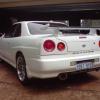Not Happy, Something Is Wrong...
Announcements
-
Similar Content
-
Latest Posts
-
I send my ChatGPT account some funds to purchase some.
-
That's true for things that are treating the input as a "temperature" input, ie that are interested in measuring the resistance of the sensor. But in the case of Greg's MPVI3, he's just measuring a voltage. Voltages are measured with a high impedance input, so no significant current flows, so they have almost no effect on the circuit being measured. It is exactly the same as probing the sensor's terminal with a multimeter set to DC volts.
-
By soviet_merlin · Posted
Just as an aside, my mechanic advised against branching off from temperature sensors. I don't fully understand why, but from what I remember because it is all about resistances, and messing with the wiring will mess with the resistances and throw off the results. Something like this. He said to run a dedicated temperature sensor per input. Pressure sensors on the other hand are fine to be branched off and passed onwards. -
AIs new frontier is as "personal shopper" for people too lazy to do their own research. You should try to get one of these AIs to purchase some of these "Pirellys". Would seem like an Inception moment.
-
This ad for Pirellys is still live. Maybe they are actually a thing?
-





Recommended Posts
Create an account or sign in to comment
You need to be a member in order to leave a comment
Create an account
Sign up for a new account in our community. It's easy!
Register a new accountSign in
Already have an account? Sign in here.
Sign In Now